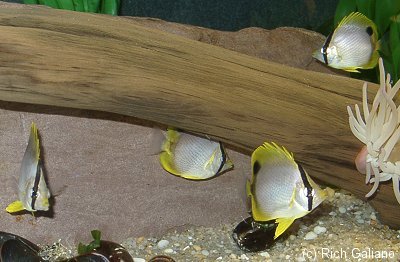An Aquarium For the Naturalist
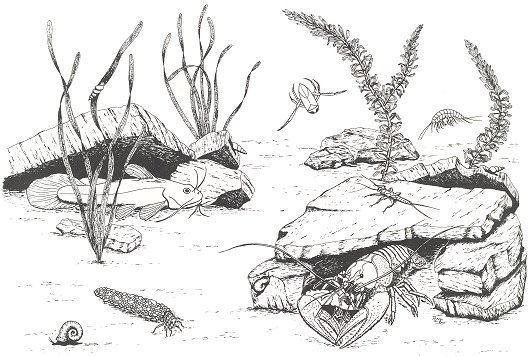
By Ronald M. Clayton
Illustrations by author
Maintaining an aquarium filled with local fish and other aquatics can be an enjoyable, learning experience, and give you a good excuse to get out and stomp around in your local pond or stream. It's fun collecting new animals and plants to add to the aquarium, to replace ones that have died, or as food for your locally acquired fish, and learning about your wildlife is a fascinating part of the experience. In the shimmering shallows and mysterious depths of almost any nearby body of water thrives a whole world of living things, some very ugly and some very beautiful - the variety will amaze you. If you are interested in providing inexpensive recreation and education for yourself and perhaps your family, read on.
What You Will Need To Buy
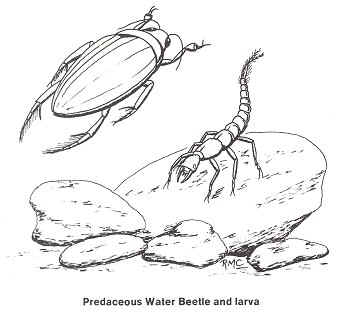
The only things you will need to purchase are: the aquarium with cover and light ( which may also be constructed from a kit or from scratch, ) an air pump and plastic tubing, a filter and filtering materials, one or two airstones, and a couple of fine-meshed dip nets. A small minnow seine ( 1/8-inch mesh ) will also be helpful, especially for collecting fish. If you are a fisherman, this seine can also be used for collecting bait, and thus will pay for itself.
Setting Up Your Aquarium
Locate your aquarium on a sturdy, waterproof surface, fill it with water, and set up the air pump. Air stones will have to be weighted down to keep them on the bottom. The filter, which aids in preventing the water from becoming cloudy, does not generally need extra weight to sink. If chlorinated tap water is used to fill the aquarium, let it sit for at least 24 hours before adding any animals. The air bubbling through the water will purge it of the chlorine, * which will kill most aquatic animals. Heating the water is not necessary, since the animals you will collect are used to varying temperatures. They should do quite well at room temperature as long as the water is well aerated.
* Note: nowadays chlorine has been replaced in tapwater by chloramine, which does not dissipate naturally. Use a water treatment from the pet store.
Collecting For Your Aquarium
Before setting out on your collecting trip, be sure to consult local regulations for collecting in the body of water you intend to visit. It is probably best to talk to. your local conservation officer and explain to him the purpose of your collecting. There are usually regulations as to net size and types of fish that may or may not be taken. Most game fish can only be taken by rod and reel. If there are no size limits on these species in a particular body of water, it is probably legal to keep small game fish in an aquarium as long as they are caught legally. Check the laws first!
You will need to take several buckets, a dip net, the seine, another person to help in seining, and either rubber boots or old shoes for foot protection. ( Your local pond or stream is almost guaranteed to harbor some rusty cans and broken bottles. ) If you will be collecting in water where the bottom is rocky, it will be helpful to have some type of non-slip soles on your footwear. The algae and slime on the rocks can make them more slippery than if they were greased.
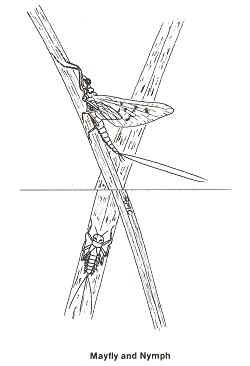
If the bottom of the stream or pond has sandy areas, collect some of the sand in one of the buckets. Also, collect some gravel from the bottom if possible. Keep these materials in separate buckets. You should take enough of these materials to cover the bottom of the aquarium to a depth of about one-half to one inch. In addition to providing a natural substrate in the aquarium, these materials will trap the detritus ( wastes and dead plant and animal material ) so that it will not be stirred up in the water by activities of the inhabitants. Collect some larger rocks ( up to about six or eight inches in diameter and fairly flat if possible ) for constructing shelters that many fish and other organisms will use for hiding, spawning, and certain social activities.
A variety of real plants will enhance the beauty and naturalness of the aquarium habitat, provide food for certain organisms, and shelter for others. Collect several different kinds of small, rooted aquatic plants from the area where you will be collecting the animals. Try not to get any algae, especially the filamentous kinds. They tend to choke your aquarium in a short period of time. If you cannot find plants free of algae, wait until you can collect some from another area with similar habitat.
The Habitat
Many types of fish, insects, and other animals will do very well in the home aquarium, but in order for them to survive and act naturally you must set up the aquarium to simulate their natural environment. Variety of habitat is the key to success if you want to keep a variety of organisms in your aquarium. For this reason, you will need to collect some of the materials that are common in the animals' environment.
The Inhabitants
Some fish live in the middle or upper depths, but most of the animals you will want to collect, including fish, crayfish, newts, snails, clams, and insects, live on the bottom or in plant beds. These are the areas where you should concentrate your efforts.
Collecting in a stream is usually easier than collecting in a pond since the bottom is usually more solid and the current can do much of the work for you. In pools and areas of slow flow, pull the seine as rapidly as possible, preferably upstream or across the current with the downstream man leading. Keep the weighted part of the seine dragging bottom as much as possible. Keep the seine moving until it is lifted from the water; if you stop, many of the animals you have caught will escape. In riffle areas one person can hold the seine stationary in the current while the other person Shuffles the bottom and splashes the water, working from a few feet upstream down toward the net. The faster the current, the farther upstream you can start your shuffling. The splashing and shuffling will dislodge animals hiding in the rocks and weeds, and the current will carry them into the net. A large dip net can be used by one person to collect in the riffles. Hold the net downstream from yourself, with one edge against the bottom between you and the net.
When seining in a pond, work parallel to the shore, then toward shore at the end of a haul. Again, remember to keep the seine moving until it is lifted from the water.
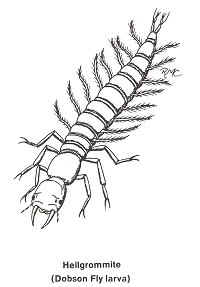
The dip net can also be used, in stream or pond, for sweeping through weedbeds and under matted vegetation or pursuing slower animals like newts, crayfish, and insects. These animals are slower than most fish, but you still have to be quick to catch them.
Snails and clams can be picked off the bottom by hand.
What Have You Collected ?
When you lift your net from the water, it is likely to contain a variety of wiggling, crawling, flopping animals of many shapes, sizes, and colors. Some will be keepers, some won't. Those fish that cannot be legally taken by net ( such as game fish ) should be returned to the water unharmed.
Fish
The most common types of fish you will probably find are of the minnow family ( carp, stone rollers, dace, minnows, chubs, and shiners ) and sucker family ( suckers, chubsuckers, hogsuckers, and redhorses. ) Darters and sculpins are also quite common. Less common fish you might catch include madtom catfish ( careful - they sting ! ) and silversides, sticklebacks, young eels, killifish, and topminnows. If you want to identify the fish you have collected ( this can be very interesting and educational, ) a good book to consult is How To Know the Freshwater Fishes by Samuel Eddy ( published by the Wm. C. Brown Co. of Dubuque, Iowa. ) Checking the natural history of the fish you collect will alert you to potential problems, such as the intolerance of sculpins for warm water.
The ability of different fish to survive handling and confinement in an aquarium varies with species and age, and differences occur even between similar-aged fish of the same species. Even with careful handling, you can expect some mortalities either during transportation or after you have put the fish in your aquarium.
Crayfish and other crustaceans
Crayfish, freshwater relatives of the lobster, are not as dangerous as they look, but they do pinch with their claws. When you pick them out of the net, grab them with thumb and forefinger, a little forward of mid-body, from above. Their claws cannot reach you in that position. The smaller ones ( less than one and one-half inches ) seem to die more often than not when put in an aquarium, but the larger ones usually do quite well. ( Incidentally, the larger ones make very good eating when boiled in salted water. The taste is similar to but milder than, that of their briney cousins. ) You will probably also find shrimp, amphipods, and other small crustaceans in your net. These serve as excellent food for your larger animals.
Newts
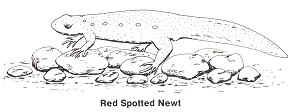
Newts are salamanders that spend their adult life in the water but do not have gills. They breathe through their skin and by occasionally gulping air at the surface. These amphibians are greenish with orange and yellow spots over most of the body. They are usually found in ponds. Most do well in an aquarium, but an occasional one will not eat. Animals should be released if you notice that they are refusing to eat and becoming thinner.
Insects
Most of the insects you will collect will be in immature stages. Only adults of the aquatic beetles and the water bugs are generally found in the water. Adults of all the others are terrestrial and are found in or on the water only when laying eggs. Do not pick up the water bugs - many of them give a painful bite.
The aquatic beetles make interesting aquarium creatures. They carry their air supply with them beneath the surface of the water in the form of an air bubble and must return to the surface periodically to replenish the supply. For some types of beetles, a film of air around part of the body acts as a gill, extracting oxygen from the water by diffusion.
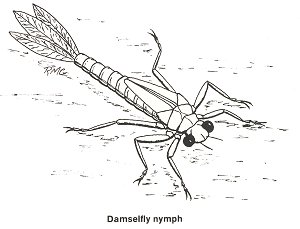
The immature stages of insects exhibit an almost unending variety of forms. Many, especially those of the flies, look more like worms than insects. The kinds of insects you are most likely to find in your net are the dragonflies and damselflies, mayflies, caddisflies, stoneflies, flies, hellgrammites, and beetles. Some of these will provide excellent food for your fish and newts, others may try to eat your fish. Many will eat each other. Some are vegetarians, and may even help control any algae that grows in your aquarium. You will want to collect as many of the smaller insects as possible as food for the other animals.
Mollusks
You will usually find snails, and occasionally a clam, in the net. Snails are great for the aquarium as they help to keep it clean. Clams sometimes do well. They don't show much activity except filtering the water for food, but they are interesting, so take them home if you find any.
Game Fish
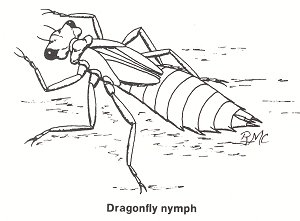
If you want to collect game fish with rod and reel, use small lures with small, barbless hooks to minimize injury to the fish. Don't keep fish over three or four inches unless you have a very large aquarium. Game fish need room to move around. These fish will usually eat almost anything alive that they can get in their mouths, including your other fish.
Handle With Care
Do not crowd your catch into a single bucket. If you are taking a large number of animals for a large aquarium, it is better to use several buckets to transport them. Too many animals in a bucket of water will deplete the oxygen rapidly and many may die before you reach home. You should also keep the buckets shaded. If the water is warmed, it will not hold as much oxygen in solution, so the oxygen present will be used up sooner. Replenish the water in all the buckets containing animals at least every half hour, or more often if the fish begin gulping for air at the surface. Refreshen the water just before you leave for home, then waste no time getting there.
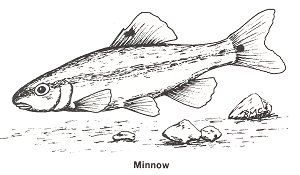
Do not transport the animals in the same bucket with the rocks you've collected, or the small animals may be crushed. Put a few plants, not too many, in each of the buckets containing animals. This seems to prevent them from getting too excited and jumping out.
Setting Up the New Environment
When you reach home, you should place the sand, gravel, rocks, and plants in the aquarium before introducing the animals. ( For this reason, you may find it more convenient to collect these materials on one trip, place them in the aquarium, then collect the animals on a second trip afield. ) Place the sand and gravel in separate areas of the bottom, allowing them to mix only where they meet. Plant roots can be embedded in these bottom materials. If a plant floats off the bottom, a rock can be used to weigh down the rooted end.
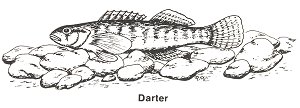
Place the larger rocks about the bottom and construct shelters opening toward the front of the aquarium so you can observe the animals hiding in them.
Now the environment of the aquarium is ready for its new inhabitants. Before placing the animals in the aquarium, check the water temperature in the buckets and the aquarium. If there is more than a few degrees difference, you should allow the animals to become accustomed to the temperature in the aquarium slowly. Place them in plastic bags with water from the buckets, then float the plastic bags in the aquarium for about a minute for each degree difference in temperature. Then release them into the aquarium. Most will swim around exploring their new home, while others will either hide under rocks and plants, burrow in the sand, or just sit on the bottom.
Different Lifestyles For Different Animals
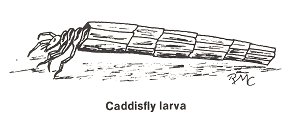
As the fish and other new members of the community become accustomed to the new habitat and to movements in the room around them, they will begin to act naturally. Some of the fish may swim in schools, while others may wander about picking at the rocks and plants, feeding on minute organisms. Some fish, along with the crayfish and certain insects, will occupy hiding places which they will attempt to defend against any intruders. The newts may wander about in search of food, fight with each other, or just sit around. If a small, flat piece of wood is floated in the aquarium, the newts will often sprawl out on it like frogs or turtles sunning themselves on a log in a pond.
Be sure to keep a cover over the aquarium that fits close around all the edges. Newts sometimes climb up the sides and try to escape. Fish may also jump out of the aquarium if it is not covered. The cover will also prevent dust and household insects from falling into the water.
Feeding And Caring For Your Pets
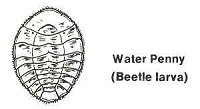
Some fish will eat commercial dried fish foods, while others will only eat bits of liver, diced worms, or live food such as small fish and insects. You will discover which types of food your fish prefer through trial and error; you must be observant to see which fish like which food.
Crayfish will eat just about any type of meat or dried food and will also eat any fish which may die and sink to the bottom.
Newts are very fond of liver, worms, and insects. They also seem to be fond of crawling on your hand.
Some of the insects will graze on the algae and detritus, while others will greedily seize pieces of meat or other insects or fish.
The snails will eat algae and minute organisms growing on the rocks, plants, and glass sides of the aquarium, and also aid in disposing of dead organisms and bits of food on the bottom. You need not worry about feeding the snails, or the clams, which filter their food from the water.
Learning About Aquatic Life

By carefully observing this aquatic community you can learn many strange and interesting things about a world that many people don't even realize exists.
You may see fish establish social hierarchies in which each fish holds a rank and dominates all the fish in lower ranks. Some animals will establish territories that they defend vigorously. Sometimes one fish will dominate all the others in the aquarium. It is a good idea to remove an overly aggressive fish before it kills the others. This aggressiveness is an expression of territorial behavior in which the fish assumes the entire aquarium as its territory.
You may learn about the many predator-prey relationships of the food web, and understand why there are many thousands of prey animals for each larger predator. Some of the animals may reproduce, and you will see why they produce many young, usually by the hundreds or thousands, so that a few will survive to adulthood.
Some creatures, such as the newts, will lose their fear of you and take food from your hand, perhaps even nip at or attack your hand.
If you are lucky enough to be observing your aquatic community at the right time, you will witness the almost unbelievable transformations made by insects such as the dragonflies, damselflies, and mayflies as the beautifully delicate adults emerge from the drab, ugly nymphs.
These and other wonders of the underwater world reveal themselves to anyone who has some curiosity and a little time.
Take Care Of Your Aquarium
Clean the aquarium, replacing the sand, gravel, and filter materials, every couple of months, feed your animals live food whenever possible, and they will provide you with many hours of learning enjoyment.
Note:
For further information on regulations regarding the netting and seining of baitfish, see the New Jersey Summary of Fishing Laws available free at sporting goods stores or from the Division of Fish, Game and Shellfisheries, P.O. Box 1809, Trenton, NJ 08625.
This article first appeared in New Jersey Outdoors - March / April 1978

